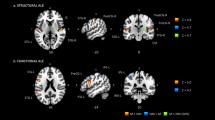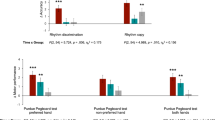Abstract
Using diffusion tensor imaging, we investigated effects of piano practicing in childhood, adolescence and adulthood on white matter, and found positive correlations between practicing and fiber tract organization in different regions for each age period. For childhood, practicing correlations were extensive and included the pyramidal tract, which was more structured in pianists than in non-musicians. Long-term training within critical developmental periods may thus induce regionally specific plasticity in myelinating tracts.
This is a preview of subscription content, access via your institution
Access options
Subscribe to this journal
Receive 12 print issues and online access
$209.00 per year
only $17.42 per issue
Buy this article
- Purchase on Springer Link
- Instant access to full article PDF
Prices may be subject to local taxes which are calculated during checkout


Similar content being viewed by others
References
Schlaug, G. & Chen, C. in The Biological Foundations of Music (eds. Zatorre, R.J. & Peretz, I.) 281–299 (New York Academy of Sciences, New York, 2001).
Gaser, C. & Schlaug, G. J. Neurosci. 23, 9240–9245 (2003).
Yakovlev, P.I. & Lecours, A.-R. in Regional Development of the Brain in Early Life (ed. Minkowski, A.) 3–65 (Blackwell, Oxford, 1967).
Nagy, Z., Westerberg, H. & Klingberg, T. J. Cogn. Neurosci. 16, 1227–1233 (2004).
Paus, T. et al. Science 283, 1908–1911 (1999).
Demerens, C. et al. Proc. Natl. Acad. Sci. USA 93, 9887–9892 (1996).
Le Bihan, D. Nat. Rev. Neurosci. 4, 469–480 (2003).
Armand, J., Olivier, E., Edgley, S.A. & Lemon, R.N. in Hand and Brain (eds. Wing, A.M., Haggard, P. & Flanagan, J.R.) 125–146 (Academic, San Diego, 1996).
de Lacoste, M.C., Kirkpatrick, J.B. & Ross, E.D. J. Neuropathol. Exp. Neurol. 44, 578–591 (1985).
Swinnen, S. & Wenderoth, N. Trends Cogn Sci. 8, 18–25 (2004).
Tanji, J. Annu. Rev. Neurosci. 24, 631–651 (2001).
Keshavan, M.S. et al. Life Sci. 70, 1909–1922 (2002).
Giedd, J.N. et al. Dev. Brain. Res. 91, 274–280 (1996).
Gyllensten, L. & Malmfors, T. J. Embryol. Exp. Morphol. 11, 255–266 (1963).
Krampe, R.T. & Ericsson, K.A. J. Exp. Psychol. Gen. 125, 331–359 (1996).
Acknowledgements
We thank I. Agartz (Human Brain Informatics at Karolinska Institutet) and P. Lindberg for providing part of the control data and J. Andersson, S. Grillner and P.E. Roland for valuable discussions and comments on the manuscript. This work was supported by the Swedish Research Council, Karolinska Institutet's Research Funds, the Jeansson Foundations, Sällskapet Barnavård and the Freemasons in Stockholm Foundation for Children's Welfare.
Author information
Authors and Affiliations
Corresponding author
Ethics declarations
Competing interests
The authors declare no competing financial interests.
Supplementary information
Supplementary Fig. 1
The outline of the cluster in the callosal isthmus, found in the regression analysis with childhood practicing, superimposed on axial sections at z = 24, from the FA images of each individual pianist. (PDF 1555 kb)
Supplementary Fig. 2
The same as Supplementary Figure 1, for the cluster in the callosal splenium, found in the regression analysis with adolescence practicing. (PDF 1533 kb)
Rights and permissions
About this article
Cite this article
Bengtsson, S., Nagy, Z., Skare, S. et al. Extensive piano practicing has regionally specific effects on white matter development. Nat Neurosci 8, 1148–1150 (2005). https://doi.org/10.1038/nn1516
Received:
Accepted:
Published:
Issue Date:
DOI: https://doi.org/10.1038/nn1516
This article is cited by
-
Neuroplasticity enables bio-cultural feedback in Paleolithic stone-tool making
Scientific Reports (2023)
-
Individual differences in rhythm perception modulate music-related motor learning: a neurobehavioral training study with children
Scientific Reports (2023)
-
A Hebbian Model to Account for Musical Expertise Differences in a Working Memory Task
Cognitive Computation (2023)
-
Music in the brain
Nature Reviews Neuroscience (2022)
-
Adaptive and maladaptive myelination in health and disease
Nature Reviews Neurology (2022)



